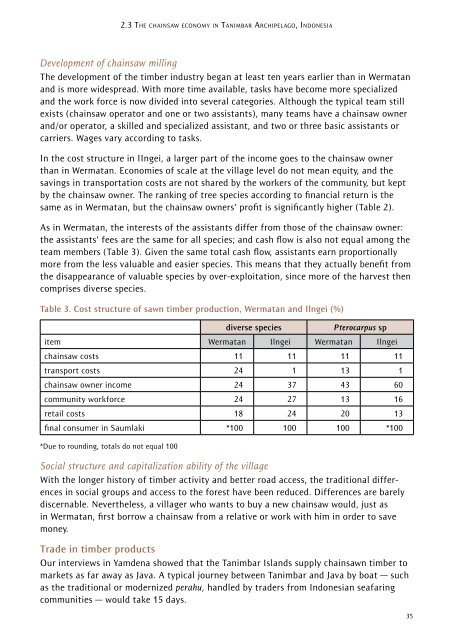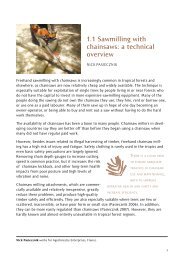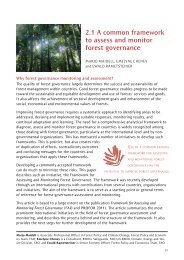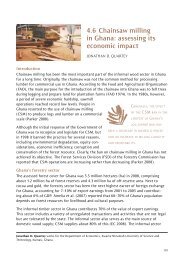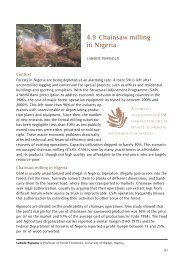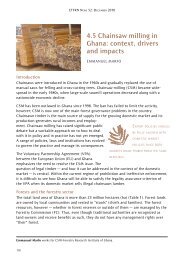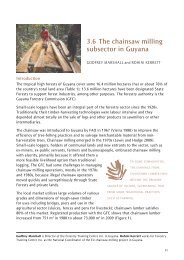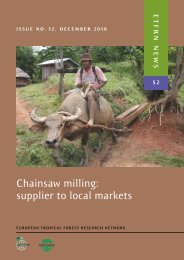Chainsaw milling: supplier to local markets - European Tropical ...
Chainsaw milling: supplier to local markets - European Tropical ...
Chainsaw milling: supplier to local markets - European Tropical ...
Create successful ePaper yourself
Turn your PDF publications into a flip-book with our unique Google optimized e-Paper software.
2.3 ThE chaiNsaw EcoNomy iN TaNimbaR aRchipElago, iNDoNEsia<br />
Development of chainsaw <strong>milling</strong><br />
The development of the timber industry began at least ten years earlier than in wermatan<br />
and is more widespread. with more time available, tasks have become more specialized<br />
and the work force is now divided in<strong>to</strong> several categories. although the typical team still<br />
exists (chainsaw opera<strong>to</strong>r and one or two assistants), many teams have a chainsaw owner<br />
and/or opera<strong>to</strong>r, a skilled and specialized assistant, and two or three basic assistants or<br />
carriers. wages vary according <strong>to</strong> tasks.<br />
in the cost structure in iingei, a larger part of the income goes <strong>to</strong> the chainsaw owner<br />
than in wermatan. Economies of scale at the village level do not mean equity, and the<br />
savings in transportation costs are not shared by the workers of the community, but kept<br />
by the chainsaw owner. The ranking of tree species according <strong>to</strong> financial return is the<br />
same as in wermatan, but the chainsaw owners’ profit is significantly higher (Table 2).<br />
as in wermatan, the interests of the assistants differ from those of the chainsaw owner:<br />
the assistants’ fees are the same for all species; and cash flow is also not equal among the<br />
team members (Table 3). Given the same <strong>to</strong>tal cash flow, assistants earn proportionally<br />
more from the less valuable and easier species. This means that they actually benefit from<br />
the disappearance of valuable species by over-exploitation, since more of the harvest then<br />
comprises diverse species.<br />
Table 3. cost structure of sawn timber production, wermatan and ilngei (%)<br />
diverse species Pterocarpus sp<br />
item wermatan ilngei wermatan ilngei<br />
chainsaw costs 11 11 11 11<br />
transport costs 24 1 13 1<br />
chainsaw owner income 24 37 43 60<br />
community workforce 24 27 13 16<br />
retail costs 18 24 20 13<br />
final consumer in saumlaki *100 100 100 *100<br />
*Due <strong>to</strong> rounding, <strong>to</strong>tals do not equal 100<br />
Social structure and capitalization ability of the village<br />
with the longer his<strong>to</strong>ry of timber activity and better road access, the traditional differences<br />
in social groups and access <strong>to</strong> the forest have been reduced. Differences are barely<br />
discernable. nevertheless, a villager who wants <strong>to</strong> buy a new chainsaw would, just as<br />
in wermatan, first borrow a chainsaw from a relative or work with him in order <strong>to</strong> save<br />
money.<br />
Trade in timber products<br />
our interviews in Yamdena showed that the Tanimbar islands supply chainsawn timber <strong>to</strong><br />
<strong>markets</strong> as far away as Java. a typical journey between Tanimbar and Java by boat — such<br />
as the traditional or modernized perahu, handled by traders from indonesian seafaring<br />
communities — would take 15 days.<br />
35


